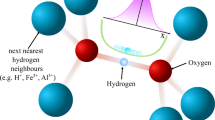Abstract
Nuclear transverse and longitudinal relaxation time measurements in solid hcp H 2 are presented for two frequencies, 5.3 and 29 MHz. The ortho molefractionX varied from 2×10−3 to 0.1 and the temperature range extended from 0.4 K to near the triple point, ∼ 13.9 K. Over this range ofX andT, the longitudinal timeT 1is representative of theintramolecular relaxation processes that reflect the orientational fluctuations of the molecules. On the other hand, the rates fromintermolecular dipolar coupling are calculated to be negligible. At concentrationsX≲0.008, the transverse timeT 2is dominated by the contributions from intramolecular relaxation processes, and is found to increase quite strongly with temperature. This new effect is ascribed to a coupling between molecular rotation and lattice vibrations, brought into evidence by the narrow width of the fluctuation spectral density at lowX. ForX>0.01 in the nondiffusion region, the NMR line shape is dominated by the signal from isolated ortho-H2 molecules broadened via intermolecular dipolar interactions, and by the signal from isolated ortho pairs and triangles, etc., configurations. Above 9 K, however, the thermally activated diffusion produces an averaging out of these broadening effects, making it possible to determine theT 2fromintramolecular nuclear spin interactions. For these mixtures,T 1also shows a temperature variation, but with a maximum near 7 K and a flat minimum at higher temperatures. The relaxation data are compared with previous experiments and some systematic discrepancies in the dependence onX are found. The frequency dependence ofT 1extends to higher concentrations than one expects from the theory of Fujio, Hama, and Nakamura, where nuclear relaxation is treated in terms of the orientational fluctuations from intermolecular electric quadrupolar coupling and crystalline fields. In the appendix, results are presented of an earlier attempt in this laboratory to determine the crystalline field splitting inH 2from the temperature variation of the NMR line shape. An upper bound of |V C/k B|=0.028 K is obtained at zero pressure.
Similar content being viewed by others
References
L. I. Amstutz, H. Meyer, S. M. Myers, and R. L. Mills,J. Phys. Chem. Solids 30, 2693 (1969).
F. Weinhaus and H. Meyer,Phys. Rev. B 7, 2974 (1973).
A. B. Harris,Phys. Rev. B 2, 3495 (1970).
C. C. Sung,Phys. Rev. 167, 271 (1968).
J. Hama, M. Inuzuka, and T. Nakamura,Prog. Theor. Phys. 48, 1769 (1972); J. Hama and T. Nakamura,Prog. Theor. Phys. 44, 303 (1970).
A. B. Harris, A. J. Berlinsky, and H. Meyer,Phys. Rev. B 7, 4720 (1973).
R. Buzerak, M. Chan, and H. Meyer,Solid State Commun. 18, 685 (1976).
W. N. Hardy and J. R. Gaines, as quoted in Refs. 4 and 5.
M. Fujio, J. Hama, and T. Nakamura,Solid State Commun. 13, 1091 (1973); M. Fujio, J. Hama, and T. Nakamura,Prog. Theor. Phys. 54, 293 (1975).
C. Ebner and C. W. Myles,Phys. Rev. B 12, 1638 (1975).
J. Constable and J. R. Gaines,Solid State Commun. 9, 155 (1971).
A. Mukherjee, Thesis, Ohio State University (1976), unpublished; A. Mukherjee and J. R. Gaines, to be published.
A. Abragam,The Principles of Nuclear Magnetism (Oxford University Press, 1961), (a) Chapter IV, Section IV; (b) Chapter IX, Section IV; (c) Chapter X, Section IV.
P. Pedroni, M. Chan, R. Schweizer, and H. Meyer,J. Low. Temp. Phys. 19, 537 (1975).
L. I. Amstutz, H. Meyer, S. M. Myers, and D. C. Rorer,Phys. Rev. 181, 589 (1969).
A. B. Harris, L. I. Amstutz, H. Meyer, and S. M. Myers,Phys. Rev. 175, 603 (1968).
L. I. Amstutz, J. R. Thompson, and H. Meyer,Phys. Rev. Lett. 21, 1175 (1968).
D. Ramm, Thesis, Duke University (1970), unpublished.
S. A. Boggs and H. L. Welsh,Can J. Phys. 51, 1910 (1973).
R. Oyarzun and J. Van Kranendonk,Can. J. Phys. 50, 1494 (1972).
W. P. Hass, N. J. Poulis, and J. J. W. Borleffs,Physica (Utr.) 27, 1037 (1961).
T. Moryia and K. Motizuki,Prog. Theor. Phys. 18, 183 (1957).
W. N. Hardy and A. J. Berlinsky,Phys. Rev. Lett. 34, 1520 (1975); W. N. Hardy, A. J. Berlinsky, and A. B. Harris, to be published.
J. C. Raich and L. B. Kanney, to be published.
T. Nakamura, private communication.
W. N. Hardy and J. R. Gaines,Phys. Rev. Lett. 19, 1417 (1967).
M. Conradi, R. Norberg, and K. Luszczynski,Bull. Am. Phys. Soc. 21, 238 (1976), and to be published.
J. R. Thompson and H. Meyer, unpublished.
Author information
Authors and Affiliations
Additional information
Research supported by a grant from the AROD and the NSF.
Rights and permissions
About this article
Cite this article
Buzerak, R.F., Chan, M. & Meyer, H. NMR relaxation measurements in solid H2 at low ortho-H2 concentrations. J Low Temp Phys 28, 415–441 (1977). https://doi.org/10.1007/BF00661440
Received:
Issue Date:
DOI: https://doi.org/10.1007/BF00661440




